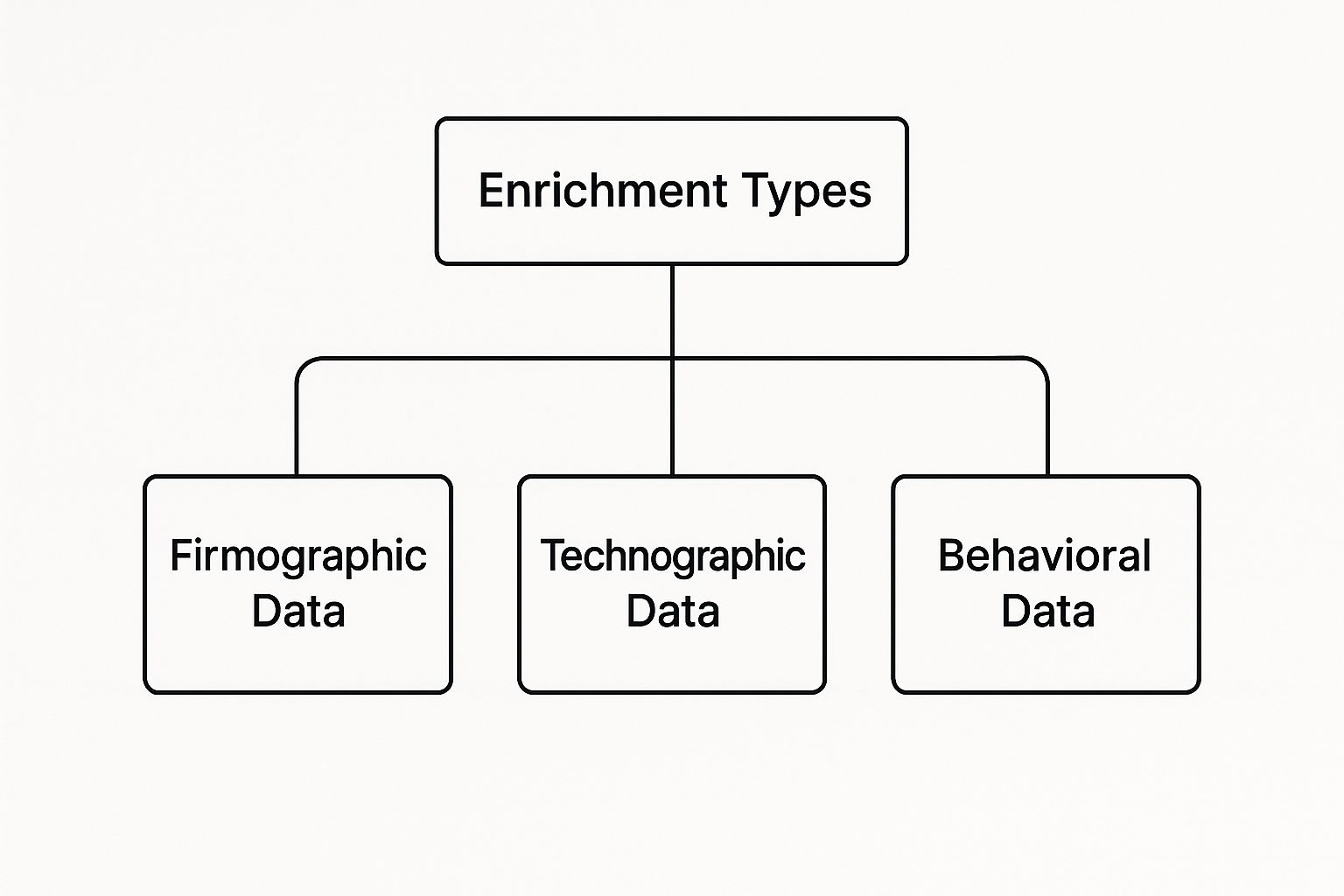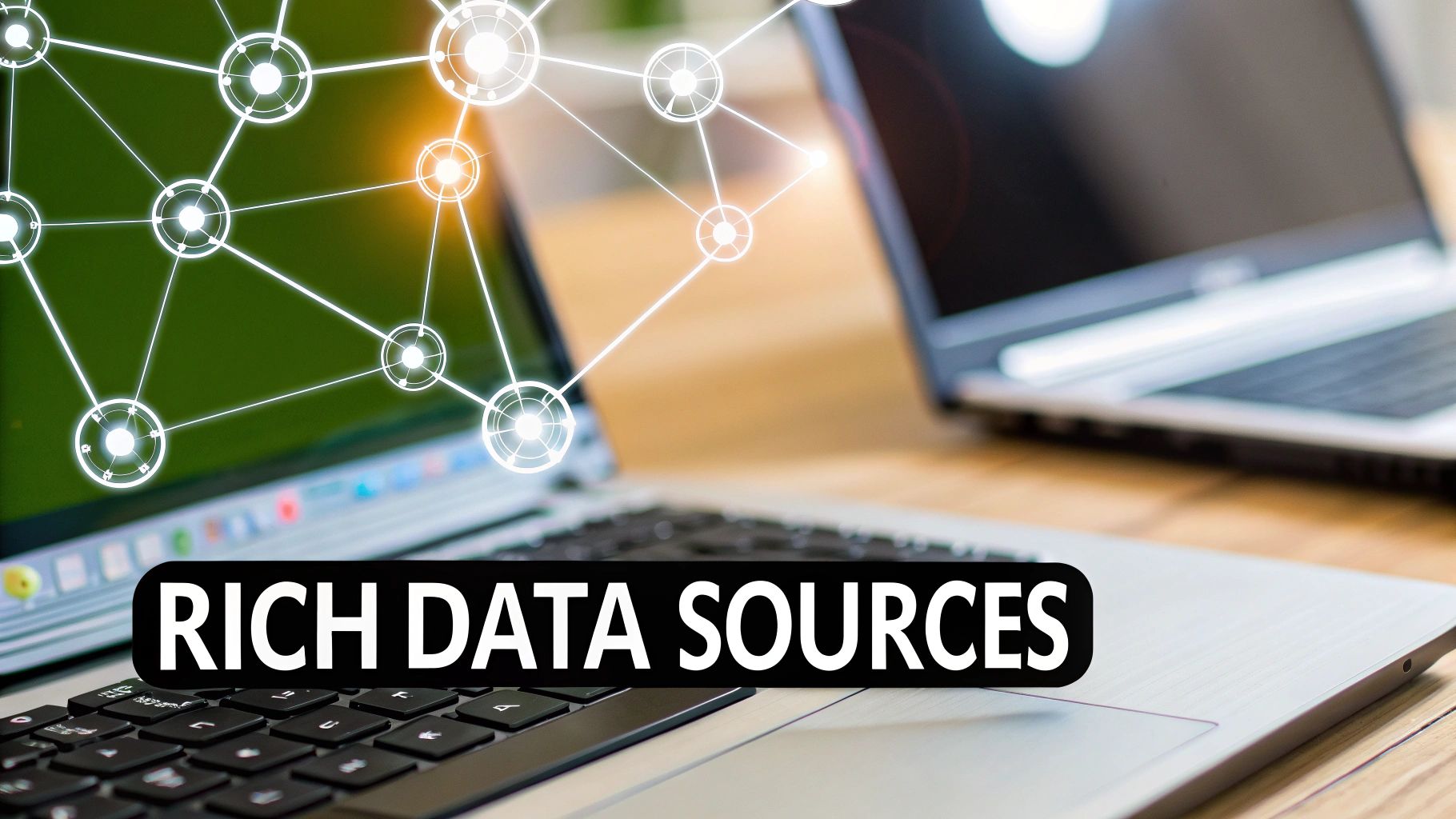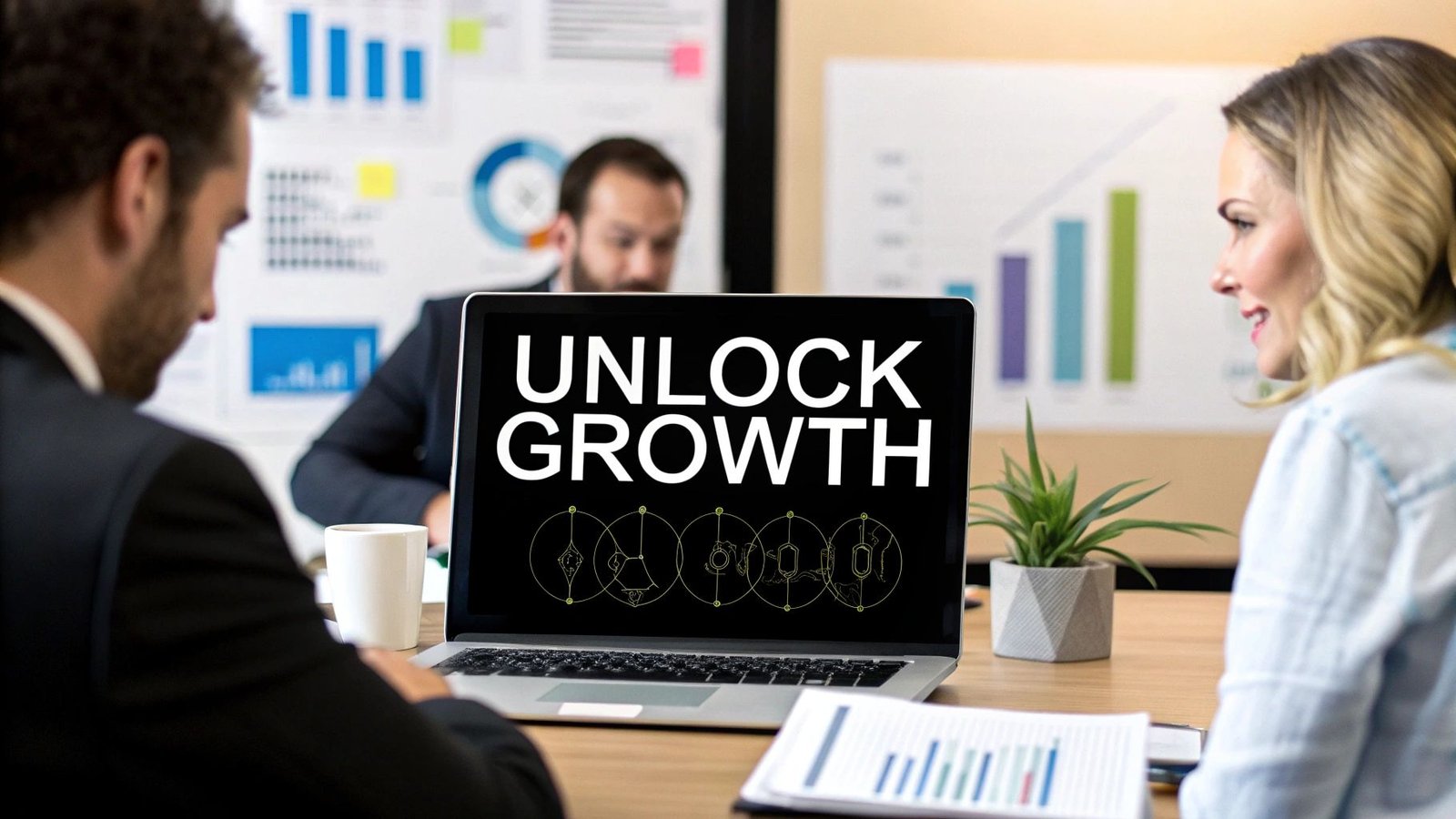Imagine your prospect list is a half-finished puzzle. You can see the basic outline, but all the crucial pieces that reveal the full picture are missing. B2B data enrichment is the process of finding and fitting those missing pieces, turning a raw list of contacts into a map of genuine opportunities.
What Is B2B Data Enrichment, Really?
Think of it as giving your entire sales and marketing operation an intelligence boost. It’s the practice of taking the customer information you already have—maybe just a name and an email from a form fill—and making it smarter, more accurate, and a whole lot more useful.
That single email address doesn't tell you much, does it? Data enrichment is what transforms that one data point into a rich story. It adds the layers of context modern sales teams need to cut through the noise and have conversations that actually matter.
From Incomplete Records to Complete Profiles
The difference between a raw contact and an enriched one is night and day. An incomplete record is a dead end. An enriched profile is an open door.
The process systematically fills in the blanks, turning a basic contact into a strategic asset. Here’s a look at what gets added:
- Firmographic Data: This is the foundational company info—industry, annual revenue, employee count, and where they're located. It's the quickest way to see if a lead even matches your ideal customer profile (ICP).
- Demographic Data: Now we're talking about the person. What’s their exact job title? How senior are they? This helps you figure out if you're talking to an intern or a decision-maker.
- Technographic Data: This is a game-changer. It reveals the tech stack a company is using. Knowing they use a competitor's tool or a piece of software that integrates with yours gives your sales team the perfect conversation starter.
- Intent Data: These are the buying signals. This data shows you which prospects are actively researching solutions like yours right now, letting you focus on the accounts most likely to buy.
According to Gartner, organizations estimate they lose an average of $15 million per year simply because of poor data quality. Data enrichment is the most direct way to fix this, turning your CRM into a reliable source of truth.
Why Enrichment Is No Longer Optional
Here's the hard truth: your database is decaying as you read this. Data goes stale. People change jobs, companies are acquired, and email addresses become invalid. Without a data enrichment strategy, your database is actively losing value every single day.
This forces your sales reps to waste hours manually researching prospects instead of actually selling. The result? Lower connection rates, sloppy targeting, and a pipeline full of missed opportunities.
B2B data enrichment isn’t just about adding more data; it's about having the right data at the right time. It transforms your CRM from a simple digital address book into an intelligent engine that drives personalization, accurate lead scoring, and a much healthier pipeline. For any serious sales team, it's a non-negotiable part of the toolkit.
What Accurate Data Actually Does for Your Business

It’s easy to talk about "clean data," but what does that really mean for the bottom line? The truth is, B2B data enrichment isn’t some IT cleanup project. It’s a strategic lever that directly grows revenue, makes your teams more effective, and sharpens your competitive edge.
You stop making educated guesses and start making confident, data-backed decisions. Sales cycles get shorter. Marketing campaigns actually hit the mark. Customers stick around longer because you genuinely understand who they are and what they need. The impact ripples across every team that interacts with a customer, creating a far more powerful go-to-market motion.
Give Your Sales Team Their Time Back
Think about a typical day for a salesperson working with a weak database. They spend hours bouncing between LinkedIn, company websites, and Google, just trying to find a direct phone number or confirm if their contact still works at the company. It’s not just inefficient; it’s a morale killer.
Reps want to be selling and building relationships, not digging for information. In fact, many sales reps spend about 27% of their working time on manual prospect research instead of actually selling. Data enrichment tools flip that script by handling the grunt work automatically.
Firms that properly implement B2B data enrichment have seen conversion rate increases of approximately 66% and significantly accelerated sales cycles. Discover more insights on the power of enriched data at Databar.ai.
When reps can trust the information in their CRM, everything changes. They can finally focus their energy on what they were hired to do: crafting great pitches and connecting with qualified buyers. That leads to more closed deals and a much happier team.
Make Personalization Possible at Scale
Generic outreach gets deleted. It's that simple. Buyers today expect you to know something about their business and their challenges before you ever hit "send." Data enrichment is what makes this level of personalization a reality, even when you're working with thousands of contacts.
Let's say your SaaS company sells project management software. Using technographic data, your sales team can instantly spot companies using an older, clunky competitor known for its poor integrations.
That lets them ditch the generic pitch and send something hyper-relevant:
- Subject: "Struggling to connect [Competitor Tool] with your other apps?"
- Opening: "I noticed your team uses [Competitor Tool] and know its limited integrations can be a real headache. Our platform connects seamlessly with the tools you already rely on, like Slack and Salesforce."
Right away, you’ve shown you understand their world and have a solution for a likely pain point. This isn't a cold pitch anymore; it's the start of a real conversation, which is how you book demos.
Sharpen Your Lead Scoring and Segmentation
Not every lead is a good lead. A solid lead scoring model is crucial for focusing your team's effort where it counts, but that model is only as good as the data it runs on. Bad data leads to bad scoring, which means your reps waste time on dead-end leads while the real opportunities go cold.
Data enrichment makes your scoring models smarter by adding the details that actually matter.
- Firmographics: Does this company's size, industry, and revenue fit your ideal customer profile?
- Technographics: Are they using technology that signals a need for your product?
- Demographics: Is your contact a decision-maker or an intern?
With this information, your scoring becomes predictive. A lead from a 500-person tech company (firmographic) that uses complementary software (technographic), where the contact is a VP of Operations (demographic), can be instantly flagged as a hot prospect. It gets automatically routed to a senior rep, ensuring your best people are always working your best leads.
What Kinds of B2B Data Can You Enrich?
To get the most out of B2B data enrichment, you have to know what kind of information you're actually adding and, more importantly, why it matters. Think of it like a detective building a case file. You start with the basics—the name, the location—and then you layer on more specific clues until a complete, actionable picture of your target emerges.
Each piece of data you add has a job to do. It helps turn a generic name on a list into a genuine opportunity.

This image perfectly illustrates how these different data layers build upon each other, starting with broad company information and drilling down to specific individual actions. Let's unpack what each of these layers really tells you.
To see how these data types work together, here's a quick breakdown of what they include and why they're so important for sales and marketing teams.
A Breakdown of B2B Data Enrichment Types
| Data Type | Information Included | Primary Use Case |
|---|---|---|
| Firmographic | Industry, company size, annual revenue, location. | Qualifying leads at a high level to ensure they fit your Ideal Customer Profile (ICP). |
| Demographic | Job title, seniority level, department, contact info. | Identifying the right decision-makers and influencers within a target account. |
| Technographic | CRM, marketing automation, cloud services, and other software a company uses. | Crafting hyper-relevant outreach based on a prospect's existing tech stack and potential integration needs. |
| Intent Data | Web browsing activity, content downloads, competitor research. | Prioritizing outreach to companies that are actively researching solutions like yours right now. |
Each category provides a different lens through which to view your prospects, giving you the context needed to make every interaction count.
The Foundation: Firmographic and Demographic Data
Firmographic data is the bedrock of your entire B2B strategy. It answers the most fundamental question you have about any lead: "Is this company even a potential fit for us?" This layer includes the absolute essentials about an organization, giving you the context to qualify or disqualify them right off the bat.
You're looking at things like:
- Industry: Do they operate in a sector you serve, like SaaS or manufacturing?
- Company Size: How many people do they employ? A 20-person startup has vastly different needs than a 2,000-person enterprise.
- Annual Revenue: Can they realistically afford your product or service?
- Geographic Location: Are they in a region your team can actually support?
Demographic data then zooms in on the specific people inside that company. It helps you figure out who you're actually talking to and if they have the influence to sign a check. This means knowing their job title, their seniority level, and where they sit in the org chart.
The Competitive Edge: Technographic Data
For SaaS and tech companies, technographic data isn't just helpful—it's a game-changer. This data reveals the complete technology stack a company is using, from their CRM and marketing tools to their cybersecurity software.
Imagine you sell a project management tool that integrates seamlessly with Salesforce. With technographic data, you can instantly pull a list of every Salesforce user in your target industry and send them a message that speaks directly to their current workflow. It’s an incredible way to stand out from the noise, and a critical step when you learn how to identify your target customers and their unique challenges.
When you know a prospect's tech stack, you can stop selling a generic product and start offering a specific, tailored solution to a problem they almost certainly have.
The Timing: Intent Data and Buying Signals
While all the other data types tell you who your prospects are, intent data is the only one that tells you what they’re thinking about right now. This behavioral data tracks a company's digital footprint across the web to see if they're actively researching solutions like yours. It’s the closest thing we have to a crystal ball in sales.
Intent data is collected from buying signals like:
- Surges in topic research: Suddenly, several employees from one company are reading articles about "customer data platforms."
- Content downloads: Someone from a target account just downloaded your latest case study or a competitor's whitepaper.
- Website visits: Key decision-makers are browsing your pricing page or your competitors' feature lists.
When you enrich your CRM with intent data, your sales team can stop guessing and start engaging prospects who are already in the market to buy. This gives them an almost unfair advantage, allowing them to join the conversation at the perfect moment.
How to Actually Enrich Your B2B Data

Knowing what data you need is one thing, but getting it is a whole different ball game. When it comes to the actual process of B2B data enrichment, there’s no single magic button. Instead, you have three main ways to get the job done, and each comes with its own trade-offs between speed, cost, and how accurate the final result is.
Figuring out which method to use really comes down to your company's size, budget, and what you’re trying to achieve. A lean startup’s needs are worlds away from a global enterprise's, so let's break down how each approach works.
The Manual Approach
Manual enrichment is exactly what it sounds like: someone on your team—or a whole group of people—digs through public sources like LinkedIn, company websites, and press releases to fill in the blanks in your database. Think of it as old-fashioned detective work.
This hands-on method is often the go-to for small businesses just starting out or for teams running a super-targeted, low-volume campaign.
The big upside? It’s cheap. You're trading time and elbow grease for software subscription fees. But its limits become obvious pretty quickly. It's incredibly slow, riddled with the potential for human error, and simply can't scale. As soon as your lead volume picks up, manual enrichment turns into a serious bottleneck.
The Automated Approach
For most modern sales and marketing teams, automation is the standard. This approach uses specialized tools and platforms that plug right into your existing systems—usually your CRM—via an API.
These tools are powered by massive, constantly updated databases of company and contact info. When a new lead comes in or you need to update an old contact, the system instantly checks its records against yours and fills in the missing pieces. It all happens in the background, in real time.
This method brings some serious advantages to the table:
- Speed and Efficiency: You can enrich thousands of records in the time it takes to make a cup of coffee. This frees up your sales reps from hours of mind-numbing research so they can focus on selling.
- Scalability: It handles growth without breaking a sweat. The process is the same whether you have ten leads or ten thousand.
- Accuracy: Good providers constantly verify their data to make sure it's fresh and reliable, which is a cornerstone of effective customer relationship management basics.
The main thing to consider here is the subscription cost. But for most companies, the ROI from a more efficient sales team and better-targeted campaigns easily justifies the investment.
The Hybrid Approach
Why not get the best of both worlds? The hybrid approach mixes the raw power of automation with the careful touch of human review. This is the strategy you’ll see in companies going after high-value accounts where getting every single detail right is non-negotiable.
In a hybrid model, an automated tool does the heavy lifting, enriching the entire database first. Afterward, a dedicated team steps in to manually double-check the data for the most important, high-priority accounts.
This ensures that when your team reaches out to their top-tier prospects, they’re working with perfect information. It's about balancing broad efficiency with surgical precision where it matters most. For anyone serious about account-based marketing (ABM), this is often the smartest way to go.
Navigating Common Data Enrichment Hurdles
https://www.youtube.com/embed/raVgEx62j70
Putting a B2B data enrichment strategy in place is one of the smartest things a company can do, but it's not a silver bullet. The road to consistently clean, useful data has its share of bumps. Knowing what these hurdles are ahead of time is the secret to building a solid data strategy that actually pays off in the long run.
From information that naturally goes stale to the technical headache of integrations, being prepared is half the battle. The most successful teams don't just put out fires; they build processes to see the problems coming and handle them from day one.
The Constant Battle Against Data Decay
Picture this: you spend months meticulously building the perfect list of prospects, only to watch it slowly fall apart. That's data decay in a nutshell, and it’s the most relentless challenge in the world of data management. People switch jobs, companies get bought, phone numbers change, and tech stacks get an overhaul. It never stops.
This isn't just a minor annoyance; it's a massive drain on resources. Research shows that a staggering 25-30% of B2B data becomes outdated every single year. For the average business, this slow rot in data quality adds up to an estimated $12.9 million in annual costs. The reality is, bad data quietly kills productivity and pipelines.
Here's the key takeaway: Enrichment can't be a one-and-done project. It has to be a continuous, automated process that constantly refreshes your records to fight back against the natural decay of business information.
This means finding a data partner that offers scheduled or even real-time updates. Your CRM needs to reflect what's happening now, not what was true three months ago.
Ensuring Data Quality and Accuracy
Let's be honest—not all data is created equal. The market is flooded with providers, but the quality of their information is all over the map. Partnering with a vendor who cuts corners on sourcing can do more harm than good, polluting your CRM with junk data and sending your sales team on wild goose chases.
You have to vet potential partners like you're hiring a key employee. Ask them the tough questions:
- Where does this data come from, and how is it verified? The best providers use a mix of smart technology and actual human verification to get it right.
- How often do you refresh your database? The more frequent the updates, the more you can trust the information.
- What's your typical match rate for our industry and target market? A high overall match rate is useless if they can't enrich the specific contacts that matter to your business.
Ignoring these points can create a domino effect of problems down the line. To really get into the weeds on this, take a look at our guide on common data quality problems and how to solve them.
Managing Integrations and Costs
A powerful enrichment tool is completely worthless if it doesn’t talk to your other systems. Seamless integration with your CRM, marketing automation platform, and other sales tools is an absolute must. A clunky setup will just create frustrating data silos and make your team want to pull their hair out.
Look for tools that have native, well-documented integrations for the platforms you already rely on. API access is also a big deal, as it gives you the flexibility to build custom workflows and keep data flowing smoothly everywhere.
Of course, you also have to keep an eye on the budget. Pricing can range from paying per record to flat-rate subscriptions.
- Usage-Based: This can be great for companies with unpredictable needs or those just getting started.
- Subscription-Based: This model is usually better for larger teams that need predictable costs they can scale with.
Take a hard look at your data volume and growth plans to pick a model that makes sense for your budget and won't lead to any nasty surprises on your invoice.
Staying Compliant with Privacy Regulations
Finally, you can't ignore the complex web of data privacy laws. Regulations like GDPR in Europe and CCPA in California have laid down strict rules about how personal and company data can be gathered, stored, and used.
Using enriched data without knowing exactly where it came from is a huge gamble. If your data vendor isn't compliant, that risk gets passed on to you, opening your business up to hefty fines and serious damage to your reputation. Make sure any partner you work with is totally transparent about their compliance measures and can show you the proof. This turns a potential legal nightmare into just another manageable piece of your data governance puzzle.
Choosing the Right Data Enrichment Partner

Picking a vendor for B2B data enrichment isn’t just another software purchase. You're choosing a partner whose work will directly shape your sales and marketing results. With a crowded market full of big promises, it’s crucial to look past the sales pitch and really understand what each provider offers.
A great partner doesn't just hand over a list of contacts; they provide the reliable, accurate, and secure data that becomes the bedrock of your entire go-to-market strategy. The right choice can turn your CRM into a powerhouse and give your teams an incredible edge. The wrong one? It can flood your database with bad info, creating more headaches than it solves. This decision is too important to rush.
How Good is Their Data, Really?
First things first: the quality of the data is everything. A provider’s database is their product, so you need to be absolutely certain it’s accurate, deep, and up-to-date. Don't be shy about asking the hard questions before you sign anything.
Kick things off by asking how they source and verify their information. Where does it all come from, and what do they do to make sure it's correct? The top-tier providers will tell you they use a mix of sophisticated tech and actual human review to keep their accuracy high.
Here's what to grill them on:
- Data Accuracy: What’s their guaranteed accuracy rate? Better yet, ask them to run a test on a small chunk of your own contact list. See the results with your own eyes.
- Data Freshness: How often do they update their records? Contact data goes stale fast—people change jobs, companies get acquired. You need a partner who is constantly refreshing their database.
- Data Coverage: Do they have solid data for your specific industries and regions? A database with millions of contacts is worthless if it’s missing the people you actually want to sell to.
Will It Actually Work With Your Tools?
An enrichment tool is only useful if it plays nicely with your current tech stack. If the software is clunky or disconnected, your team will just get frustrated and stop using it. You're looking for something that feels like a natural part of your CRM, not a bolt-on headache.
Look for providers with clean, well-documented integrations for the tools you live in every day, like Salesforce, HubSpot, or Marketo. The interface has to be intuitive, too. Your sales reps should be able to find and use the enriched data without needing a PhD in computer science.
A seamless integration ensures that enriched data flows automatically where it's needed most, turning your CRM from a simple database into a dynamic intelligence engine that actively helps your team sell smarter and faster.
What’s the Cost and Are They Compliant?
Finally, you need a partner that fits your budget and keeps you on the right side of privacy laws. The B2B data enrichment market is booming, and you have options. Valued at around $5 billion in 2025, the global market is expected to grow at a CAGR of 15% and could even triple by 2033. You can read more about this market's rapid expansion at Market Report Analytics.
Pricing models are all over the place, from paying per contact to flat monthly subscriptions. Figure out your own data needs to see which model makes the most sense. Most importantly, double-check that the provider is compliant with regulations like GDPR and CCPA. They should be totally transparent about where their data comes from, proving they're committed to ethical practices that protect your business from major legal and financial risks.
Have Questions? We've Got Answers.
Jumping into B2B data enrichment often brings up a few key questions. Let's walk through some of the most common ones we hear from sales and marketing leaders who are serious about getting their data right.
How Often Should We Enrich Our B2B Data?
Think of your contact database like a garden. If you just plant it and walk away, it's not going to thrive. Data goes stale faster than you might think—some estimates show B2B data decays by 25-30% every single year.
That's why data enrichment can't be a one-and-done task. You need a consistent approach. The best practice is to set up a continuous enrichment cycle or, at the very least, a quarterly refresh. This keeps your sales team from wasting time on contacts who've already moved on to new roles or companies.
How Does Data Enrichment Fuel an ABM Strategy?
Account-Based Marketing (ABM) is all about focusing your energy on a handful of high-value accounts. To do that effectively, you need to know them inside and out. Data enrichment is what makes that deep understanding possible.
It's the fuel for your ABM engine, delivering the firmographic, technographic, and intent data you need to:
- Find the perfect accounts: Stop guessing and start identifying companies that are a true fit for your solution.
- Personalize everything: Write outreach that actually connects because you understand their tech stack, their pain points, and their recent buying signals.
- Map out the key players: Uncover the entire buying committee, not just one or two contacts.
An ABM campaign without rich data is really just a shot in the dark. Enrichment gives you the intelligence to target the right people at the right companies with a message that truly lands, massively boosting your odds of success.
Is Using Enriched B2B Data GDPR Compliant?
Compliance is a big deal, and it's a responsibility you share with your data provider. The short answer is yes, using enriched data can be fully compliant with regulations like GDPR. The key is working with a partner who sources their data ethically and transparently.
Make sure you choose a provider that is upfront about how they collect their information and can prove their commitment to privacy laws. The best vendors have compliance baked into their DNA, allowing you to use B2B data enrichment to grow your business without taking on avoidable legal risks.
Ready to turn that incomplete contact list into a revenue-generating machine? The Nordic Lead Database gives you access to the most extensive and accurate data on decision-makers and companies across the Nordics. Get started today.
